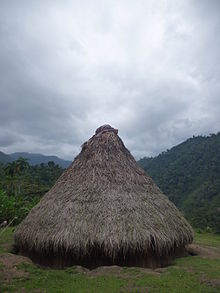Cabécar people


The Cabécar are an indigenous group of the remote Talamanca region of eastern Costa Rica. They speak Cabécar, a language belonging to the Chibchan language family of the Isthmo-Colombian Area of lower Central America and northwestern Colombia. According to census data from the National Institute of Statistics and Census of Costa Rica (Instituto Nacional de Estadística y Censos, INEC), the Cabécar are the largest indigenous group in Costa Rica with a population of nearly 17,000.[1]
Cabécar territory extends northwest from the Río Coen to the Río Reventazón.[2] Many Cabécar settlements today are located inside reserves established by Costa Rican law in 1976 to protect indigenous ancestral homelands.[3] These reserves exhibit ecological diversity, including vast swaths of tropical rainforest covering steep escarpments and large river valleys where many Cabécar still employ traditional subsistence livelihoods and cultural practices.
| Total population | |
|---|---|
| 17,000 | |
| Regions with significant populations | |
| Languages | |
| Cabécar, Spanish | |
| Related ethnic groups | |
| Bribri |
History
Language
Cabécar is one of sixteen remaining languages in the Chibchan family of the Isthmo-Colombian Area, a region of lower Central America (specifically eastern Honduras, Nicaragua, Costa Rica, and Panama) and northwestern Colombia bifurcating the areas of Mesoamerican and South American linguistic traditions.[4] The extensive geographic distribution of the Chibchan language family has sparked debate among scholars regarding the origin and diffusion of Chibchan languages. Two conceptual models have emerged to describe possible scenarios: the Theory of North Migration and the Centrifugal Expansion Theory. The former postulates Colombia as the historical epicenter from which Chibchan linguistic groups migrated northwestward into present-day Panama, Costa Rica, Nicaragua, and Honduras.[4] However, anthropological and archaeological evidence (see Cooke and Ranere 1992; Fonseca and Cooke 1993; Fonseca 1994),[5][6][7] combined with glottochronological studies (see Constenla 1981, 1985, 1989, 1991, 1995),[8][9][10][11][12] prefer the Centrifugal Expansion Theory suggesting that Chibchan-speaking groups developed in-situ over a long period of time from an origin at the Talamanca mountain range of present-day Costa Rica and Panama. From there, Chibchan linguistic groups migrated and settled as far north as eastern Honduras and as far south as Colombia.[4]
References
- ^ "Censo 2011". INEC Costa Rica. Instituto Nacional de Estadística y Censos. 2011. Retrieved 18 February 2016.
- ^ Stone, Doris (1962). The Talamanca Tribes of Costa Rica. Cambridge, Masachusetts: The Peabody Museum.
- ^ Berger, Marcos Guevara and Rubén Chacón Castro (1992). Territorios en Costa Rica: Orígenes, Situación Actual y Perspectivas. San José, Costa Rica: García Hermanos S.A.
- ^ a b c Quesada, J. Diego (2007). The Chibchan Languages. Cartago, Costa Rica: Editorial Tecnológica de Costa Rica.
- ^ Cooke, Richard G. and Anthony J. Ranere (1992). The Origin of Wealth and Hierarchy in the Central Region of Panama (12000 - 2000 BP) with Observations on Its Relevance to the History and Phyolgeny of Chibchan-Speaking Polities in Panama and Elsewhere. In Lange (ed.). pp. 243–326.
- ^ Fonseca, Oscar and Richard Cooke (1993). El sur de América Central: contribución al estudio de la región histórica chibcha. Madrid: FLACSO: In Carmack (ed.) "Historia General de Centroamérica". pp. 217–282.
- ^ Fonseca, Oscar (1994). "El concepto de Area de Tradición Chibchoide y su pertinencia para entender la Gran Nicoya". Vínculos, Vol. 18, No. 19 (209-227).
- ^ Constenla, Adolfo. Comparative Chibchan Phonology. University of Pennsylvania: Unpublished Ph.D. Dissertation.
- ^ Constenla, Adolfo (1985). "Clasificación léxico-estadística de las lenguas de la familia chibcha". Estudios de Lingüística Chibcha 2: 15-66.
- ^ Constenla, Adolfo (1989). "Subagrupación de las lenguas chibchas: Algunos nuevos indicios comparativos y léxico-estadísticos". Estudios de Lingüística Chibcha 8: 17-72.
- ^ Constenla, Adolfo (1991). Las lenguas del Area Intermedia. San José, Costa Rica: Editorial de la Universidad de Costa Rica.
- ^ Constenla, Adolfo (1995). "Sobre el estudio diacrónico de las lenguas chibchenses y su contribución al conocimiento del pasado de sus hablantes". Boletín del Museo del Oro, 38-39: 13-55.
